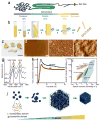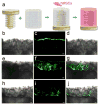Regenerated silk materials for functionalized silk orthopedic devices by mimicking natural processing
- PMID: 27697669
- PMCID: PMC5104183
- DOI: 10.1016/j.biomaterials.2016.09.014
Regenerated silk materials for functionalized silk orthopedic devices by mimicking natural processing
Abstract
Silk fibers spun by silkworms and spiders exhibit exceptional mechanical properties with a unique combination of strength, extensibility and toughness. In contrast, the mechanical properties of regenerated silk materials can be tuned through control of the fabrication process. Here we introduce a biomimetic, all-aqueous process, to obtain bulk regenerated silk-based materials for the fabrication of functionalized orthopedic devices. The silk materials generated in the process replicate the nano-scale structure of natural silk fibers and possess excellent mechanical properties. The biomimetic materials demonstrate excellent machinability, providing a path towards the fabrication of a new family of resorbable orthopedic devices where organic solvents are avoided, thus allowing functionalization with bioactive molecules to promote bone remodeling and integration.
Keywords: Biomimetic; Orthopedic; Self assembly; Silk.
Copyright © 2016 Elsevier Ltd. All rights reserved.
Figures




Similar articles
-
Foundation of the Outstanding Toughness in Biomimetic and Natural Spider Silk.Biomacromolecules. 2017 Dec 11;18(12):3954-3962. doi: 10.1021/acs.biomac.7b00990. Epub 2017 Oct 17. Biomacromolecules. 2017. PMID: 28954189
-
Biomimetic fibers made of recombinant spidroins with the same toughness as natural spider silk.Adv Mater. 2015 Apr 1;27(13):2189-94. doi: 10.1002/adma.201404234. Epub 2015 Feb 16. Adv Mater. 2015. PMID: 25689835
-
Conserved C-terminal domain of spider tubuliform spidroin 1 contributes to extensibility in synthetic fibers.Biomacromolecules. 2012 Feb 13;13(2):304-12. doi: 10.1021/bm201262n. Epub 2012 Jan 12. Biomacromolecules. 2012. PMID: 22176138
-
Spider Silk-Inspired Artificial Fibers.Adv Sci (Weinh). 2022 Feb;9(5):e2103965. doi: 10.1002/advs.202103965. Epub 2021 Dec 19. Adv Sci (Weinh). 2022. PMID: 34927397 Free PMC article. Review.
-
Basic Principles in the Design of Spider Silk Fibers.Molecules. 2021 Mar 23;26(6):1794. doi: 10.3390/molecules26061794. Molecules. 2021. PMID: 33806736 Free PMC article. Review.
Cited by
-
3D Printing of Monolithic Proteinaceous Cantilevers Using Regenerated Silk Fibroin.Molecules. 2022 Mar 26;27(7):2148. doi: 10.3390/molecules27072148. Molecules. 2022. PMID: 35408547 Free PMC article.
-
Thermoplastic moulding of regenerated silk.Nat Mater. 2020 Jan;19(1):102-108. doi: 10.1038/s41563-019-0560-8. Epub 2019 Dec 16. Nat Mater. 2020. PMID: 31844276 Free PMC article.
-
Fiber-Based Biopolymer Processing as a Route toward Sustainability.Adv Mater. 2022 Jan;34(1):e2105196. doi: 10.1002/adma.202105196. Epub 2021 Oct 13. Adv Mater. 2022. PMID: 34647374 Free PMC article. Review.
-
Orientational Mapping Augmented Sub-Wavelength Hyper-Spectral Imaging of Silk.Sci Rep. 2017 Aug 7;7(1):7419. doi: 10.1038/s41598-017-07502-3. Sci Rep. 2017. PMID: 28785090 Free PMC article.
-
Silk reservoir implants for sustained drug delivery.ACS Appl Bio Mater. 2021 Jan 18;4(1):869-880. doi: 10.1021/acsabm.0c01382. Epub 2021 Jan 6. ACS Appl Bio Mater. 2021. PMID: 36284598 Free PMC article.
References
-
- Magoshi J, Magoshi Y, Becker MA, Nakamura S. In: Polymeric materials encyclopedia. Salamone JC, editor. CRC Press; Boca Raton, FL: 1996. pp. 667–679.
-
- Jin HJ, Kaplan DL. Mechanism of silk processing in insects and spiders. Nature. 2003;424(6952):1057–1061. - PubMed
-
- Luo J, Zhang L, Peng Q, Sun M, Zhang Y, Shao H, Hu X. Tough silk fibers prepared in air using a biomimetic microfluidic chip. Int J Biol Macromol. 2014;66:319–324. - PubMed
-
- Sun M, Zhang Y, Zhao Y, Shao H, Hu X. The structure-property relationships of artificial silk fabricated by dry-spinning process. J Mater Chem. 2012;22(35):18372–18379.
-
- Zhou G, Shao Z, Knight DP, Yan J, Chen X. Silk Fibers Extruded Artificially from Aqueous Solutions of Regenerated Bombyx mori Silk Fibroin are Tougher than their Natural Counterparts. Adv Mater. 2009;21(3):366–370.
MeSH terms
Substances
Grants and funding
LinkOut - more resources
Full Text Sources
Other Literature Sources

